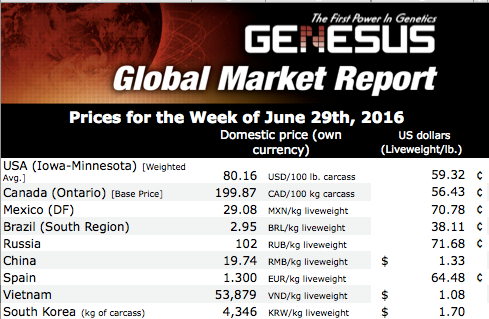



China Hog Market: How are China's Pork Markets Developing?
ANALYSIS - China is a pork-based meat-eating country, when Chinese people say meat they mean pork. Other meats are described such as chicken meat, beef meat and so on, writes Alex Kovachevich, Genesus General Manager China.Half of the world’s pigs are in China, while the human population is only around 25 per cent of the global population.
According to the World Bank1 in 1960 only 16 per cent of the Chinese population lived in cities, the rest were living in rural areas, by 2014 the per cent of urban dwellers had sky rocketed to 54 per cent! In Chinese villages most families will raise a few pigs for sale and their own meat supply.
At the same time as the Chinese population was moving in the cities their industry also grew tremendously, with very little implementation of their own environmental law. This has led to serious pollution - air, water and land are all affected.
In the last decade the Chinese government has gradually improved its environmental laws and more recently made its implementation much more rigid.
While 5 years ago pig farms had little environmental supervision, larger farms are now closely monitored, new farms need to have local villagers' approval and even in China NIMB (Not in my backyard) issues have become an impediment.
Now, to build a new farm also requires an environmental permit, which is the same process as for a new factory. Although the waste water emission standards for a farm or factory are different, most farms are not built near a sewerage treatment facility and so they need to completely fund their own waste water treatment.
For Chinese pork producers, especially the larger ones with more government supervision, environmental compliance for the owners of these operations requires a big change in their psyche and financial planning. However in the light of the serious environmental damage it faces, China has no choice and this strictness to environmental protection is a popular policy in China among the general population.
At the same time as China's countryside empties out, the pig production industry faces the need to modernise, partially due to the high cost of small family style farming and its low level of biosecurity and environmental compliance, but also due to the simple fact that labour for farms is getting extremely scarce and large scale modern production is the only way to increase margin.
Chinese pork producers are getting bigger and more professional, but of the 11 largest Pork companies, production was “only” 23 million2 market hogs a year (2015), accounting for 3.2 per cent of the current overall production of 718 million hogs in 2015, with the rest being produced in much smaller operations.
All the larger companies are planning aggressive expansions of almost ten times3 their current production in the next 5 to 10 year, due to not only the current high pork prices, but also due to their need for growth to supply their own integrated systems and increase market share.
The Chinese MOA3 estimates pork production in tonnes will increase 10 per cent from 2015 to 2025 - it says that large scale producers will still only account for 26 per cent of that. Quite a small percentage when compared to the world wide pork industry. So basically we need to assume that for various reasons - land, labour, environmental requirements - new farms will be slow to be built.
As China’s population further urbanises, families won’t have the ability to raise their own pigs in the villages as they have in the past. As living standards rise and taste for pork becomes more refined, then the demand for tasty pork also increases.
The MOA’s report3 estimates that pork imports to China will rise 15 per cent from 2015 to 2025, from 780,000T to 900,000T.
This writer thinks this estimate is impossibly low considering the current changes in China’s population structure to a non-agri base and their improving standard of living. The Chinese pork industry is entering a phase of improvement and upscaling, but at the same time a larger per cent of its pork will be sourced from global markets.
What can we take away from this? Firstly, the demand for high quality genetics will be growing in China as farm size and professionality grows.
Secondly, as the demand for pork and more importantly tasty pork grows in China, then the Chinese consumer will put more pressure on producers both in China and out to use a genetic that is focused on meat quality.
Genesus wins on both points with the ease of management, highly prolific performance of Genesus genetics and our emphasis on meat quality.

- http://data.worldbank.org/indicator/SP.URB.TOTL.IN.ZSend=2014&locations=CN&start=1960&view=chart
- Information from CSEA China Market Report 2016 May and the Chinese MOA Pork Production 5 year plan 2016
- Wens ( Currently Producing 15 Millions hogs a year, targeted to reach 78 Million in 10 years); Truein ( Currently Producing 1.7 Millions hogs a year, targeted to reach 10 Million in 5 years); ZhengBang ( Currently Producing 1.5 Millions hogs a year, targeted to reach 10 Million in 3 years)









